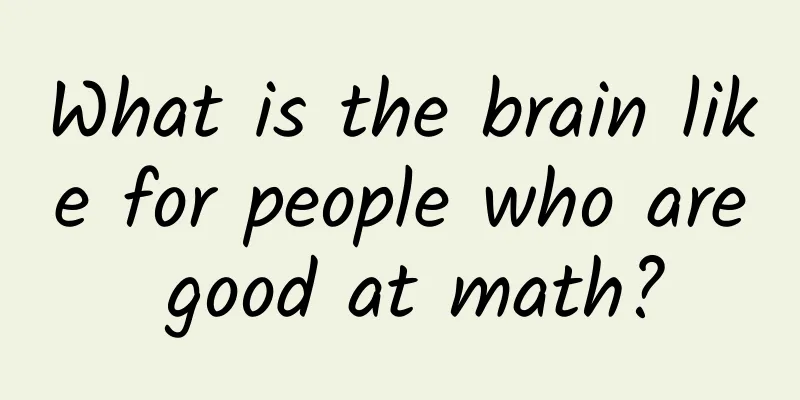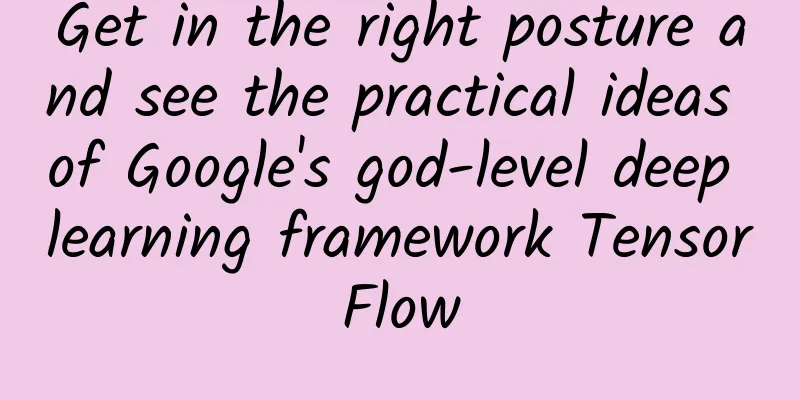What is the brain like for people who are good at math?

|
November 2022 is not special on the calendar, but it is an important month for the mathematics community. At the beginning of this month, internationally renowned mathematician Yitang Zhang published an article titled "Discrete Mean Estimation and Landau-Siegel Zeros" to explore the foundations of mathematics; at the end of the month, another internationally renowned mathematician Terence Tao and his students updated their paper on the periodic tiling conjecture, solving geometric problems from a novel perspective. Internationally renowned mathematician Zhang Yitang Zhang Yitang is considered a "legend" in the mathematics world. He entered a prestigious university when he was young, and despite his rough life, he never forgot to study mathematics. Terence Tao is even more special. He became a tenured professor at the age of 24 and won the Fields Medal, one of the highest international awards in mathematics, at the age of 31. From this point of view, mathematicians seem to be extraordinary - do they have special brains? Weighing the brain Generally speaking, when we think about a problem, we hear sounds in our heads. However, Einstein said that when he thought about math problems, various symbols and images appeared in his mind. From this, we can infer that people who are good at math may have a special brain. But what is so special about it? The most obvious answer is the size and appearance of the brain. At the end of the 18th century, French anatomist Franz Joseph Gall believed that the cerebral cortex consists of 27 regions, each of which is like an independent organ. Leg muscle atrophy will affect athletic ability; similarly, if the cortex related to memory is too small, memory may be poor. How did Gall come to this conclusion? It's a little funny. When Gall was young, he suffered from poor memory. One day, he suddenly realized that those around him with excellent memory all had large and prominent eyes. The shape of the eyes is related to the skull, and the most important organ of human beings, the brain, is "surrounded" by the skull... After adulthood, he spent all day dealing with various extreme groups, such as genius poets, mathematical prodigies, crazy criminals, etc., and collected a large number of skull specimens, gradually perfecting his theory. Gall's theory However, Gall always encountered some unexplained phenomena. Napoleon's surgeon once sent him some cases, one of which was a patient who had injured his forehead due to fencing. According to Gall's theory, whichever area was damaged would lose the corresponding function. The patient's memory seemed to consist of two parts - he could recognize the faces of his friends, but he couldn't call their names; in addition, his right limbs were paralyzed, while the left side was still normal. Why would a damage to the cerebral cortex produce such complex manifestations? More direct evidence comes from the study of Einstein's brain. Before his death, Einstein wanted his ashes to be scattered. Perhaps out of curiosity, the person in charge of the routine autopsy secretly left Einstein's brain, allowing us to get a glimpse of the ordinary genius - research shows that Einstein's brain is smaller than that of ordinary people. So it seems that brain size and appearance have little to do with mathematical ability. Functional positioning So, could mathematical talent be linked to specific brain regions? Think about the patient mentioned earlier, who lost some motor skills and some language skills. Perhaps the brain is like a computer, but its processors are distributed? This statement is not without reason. The brain is located in a special position and relies on bioelectricity to work, which is not as intuitive as joint movement. Therefore, the study of brain function often revolves around special abnormalities. For example, French neuroscientist Stanislas Dion once met a peculiar patient, Mr. M. Mr. M is an artist who is very familiar with the cultures of various countries and speaks very elegantly, but he has lost the most basic mathematical talent, that is, comparing the size of numbers. If you write 5 and 6 on the blackboard, he doesn't know which one is bigger and which one is smaller. Examination showed that the right posterior parietal cortex of his brain was damaged. The cerebral cortex is located on the outermost side of the brain. From an evolutionary perspective, it is the latest brain tissue to appear. Vertically, it is divided into 6 layers, each layer is about 1.6 square meters; horizontally, from front to back are the frontal lobe, parietal lobe, occipital lobe, and temporal lobe on both sides. The posterior parietal cortex, roughly above the back of the head, is related to numerical intuition. Scientists speculate that there is a vertical axis hidden here, just like the coordinate axis in math class, which records our perception of numbers. A 2015 study showed that the development of the posterior parietal cortex is indeed related to the mathematical ability of elementary school students. Cerebral cortex However, the posterior parietal lobe is a relatively early maturing part of the brain. Under the stimulation of family tutoring and school education, this area is fully developed at the age of 8. Moreover, mathematics is not as simple as comparing sizes. Take Mr. M for example. Although he cannot compare the size of numbers, he can perform simple multiplication operations based on the multiplication table in his memory. Most importantly, the brain is remarkably plastic. Traditionally, it is believed that when we are born, our brains have tens of billions of immature nerve cells. As we age, they gradually mature and connect to each other using synapses to form networks with specific functions. However, a study published in Nature in 2022 showed that adults also have a large number of isolated synapses in their brains. In other words, we have the ability to learn throughout our lives. Clues from red blood cells In fact, with the help of EEG, MAG and other technologies, scientists have found many neural networks related to basic functions in the brain, such as the digital intuition brain area mentioned above. However, for complex tasks, scientists still have no way to accurately locate them. Think about how complicated mathematics is - to solve a math problem, you first need to read the problem, and this step alone requires vision, language, memory, analysis and attention control. In this case, some researchers thought of the connection between different brain regions. Since mathematics involves different brain regions, perhaps the speed of communication between these brain regions determines a person's mathematical ability. Structurally, nerve cells are a bit like data cables, with connectors at both ends and a large number of synapses; in the middle is a cable made up of nerve fibers. The total length of nerve fibers in the brain is about 170,000 kilometers, which is longer than the total operating mileage of China's railways. According to their distribution, they can be divided into two categories: one is connected to the surrounding nerve cells; the other "travels through mountains and rivers" to connect distant brain areas. Studies on patients with brain damage have shown that seemingly ordinary addition, subtraction, multiplication and division are not simple at all. Each mathematical ability relies on different neural networks, and these networks rely on nerve fibers to communicate. The most direct evidence comes from functional magnetic resonance imaging. No matter how special nerve cells are, they cannot do without oxygen. The more active the brain area, the more oxygen it needs. The combination of red blood cells and oxygen will affect their own magnetic field signals. Therefore, through special magnetic fields, we can find the most active areas in the brain. Using functional magnetic resonance imaging, scientists have found that continuous subtraction activates the prefrontal and inferior parietal cortices, while multiplication involves more brain regions, possibly even the claustrum, a structure located in the inner layer of the cerebral cortex and about the thickness of a sheet of paper. Although it may seem insignificant, it is likely related to complex cognitive phenomena such as consciousness. The mystery of epiphany At this point, we can draw a conclusion: the quality of mathematical ability is related to the development of basic brain areas and the connections between various brain areas. For example, Dutch neuroscientist Martin van den Heuvel found that the pattern of neural connections between different brain areas can explain 1/3 of the difference in intelligence. But is this really the case? Let's look at a special example. According to legend, Archimedes spent all day thinking about how to identify the authenticity of a crown, and suddenly realized the secret of buoyancy while taking a bath. French mathematician Henri Poincare also said that solving mathematical problems is often not smooth sailing, and you always have to try various things first, until "there is no way out", and the answer appears inadvertently. This is enlightenment, one of the most pleasant experiences in the learning process. In order to study this phenomenon, researchers from the Chinese Academy of Sciences prepared some brain teasers. Unlike quizzes, brain teasers often require breaking the mindset, which is the most unique feature of epiphany. The results of the study can be summarized in two sentences: first, the volunteers' visual spatial information processing network was widely activated; second, the anterior cingulate gyrus released a special current in the process of racking their brains. The former conclusion means that when we encounter difficult problems, we will instinctively use visual information such as symbols to think. From this perspective, there is nothing special about Einstein's thinking mode. The latter conclusion is very interesting - the anterior cingulate gyrus is located on the inner side of the frontal lobe and is related to executive function. If the various areas of the brain are compared to "performers", the frontal lobe is equivalent to the "conductor". It will issue reminders in time when errors occur and coordinate the work of various brain areas; conversely, when faced with familiar things, its activity will decrease to a certain extent. What conclusions can we draw from the working state of the frontal lobe and the connections between the brain regions mentioned above? The connections between the brain regions are by no means static, but will adjust as we learn and think. The key to good mathematics At this point, we can make a brief summary: mathematical ability is first affected by the development of basic brain areas. Most people have already passed this stage with the help of their parents and teachers. Secondly, it depends on the connection between various brain areas. After learning new formulas and theorems, whether one can understand and grasp them thoroughly, and whether one can quickly establish connections with existing knowledge. However, the most important thing is the working state of the frontal lobe. The frontal lobe is the last area in the brain to mature, and is closely related to higher cognitive behaviors such as planning, execution, and attention control. From this perspective, it is equivalent to a "brain within the brain." For example, it is traditionally believed that boys have better math talent, but a 2008 study involving 270,000 people across 40 countries showed that girls' math ability is not bad, but social prejudice affects people's confidence in math. Large-scale surveys show that more than 90% of people have experienced math anxiety. What's more interesting is that when we are anxious about math problems, the brain areas related to pain will be activated. In other words, math anxiety can cause real pain. In the long evolution, pain often means survival issues. Therefore, when anxious, the efficiency of the frontal lobe will decrease to save brain power to deal with the survival crisis; accordingly, the higher the anxiety level, the worse the math performance may be. Another thing worth noting is autonomy. In 2019, a study of nearly 1,000 middle school students in Hubei Province showed that those with strong initiative were more willing to work hard for their studies and had better academic performance. When Mr. Hua Luogeng was in primary school, he failed in mathematics. When he was in middle school, he suddenly realized that learning mathematics requires long-term efforts, and that mathematics is needed for the construction of the motherland and personal life. Such an important thing should be learned actively. So, there is no such thing as talent. Experts in various fields have just gradually found the laws of things through long-term trial and error. Text/Zhao Yanchang Picture/Internet |
Recommend
Virtual reality technology has been initially applied in enterprises
[[125122]] Virtual reality-based prototyping and ...
What are the functions of the Guangzhou WeChat restaurant ordering mini program? How much does the WeChat food ordering app cost per year?
With the continuous development of the Internet, ...
Decoding the power of Snapchat from my social product syllogism
Snapchat is finally going public. The company has...
A complete analysis of the Toutiao search account setup and delivery ideas
As a new search platform launched this year, Tout...
3 tips for high-conversion promotion creativity!
What kind of creative has a high click-through ra...
Fight to the end "Fight" big screen TV version "Ximi Mahjong: Fight to the end"
Screen: Sound Effects: operate: Plot: Experience:...
Argo AI develops 400-meter lidar, which is expected to be installed on Ford's driverless taxis next year
Autonomous driving technology company Argo AI has...
If you don’t understand these, don’t start a community!
I was recently asked: How do you understand commu...
The second generation of COVID-19 vaccine is here! Do you still need it after taking the first generation?
On December 27, the UAE Ministry of Health and Pr...
How much does a WeChat mini program cost? How much does it cost to make a WeChat mini program?
As an application based on the WeChat ecological ...
RESTful API Design and .NET Core Implementation
With the rapid development of network technology,...
315 Consumer Rights Day丨Many of the “Internet celebrity hot products” are artificially created, are your consumer rights still there?
When you think of March, what comes to your mind ...
How to attract accurate fans on WeChat? 10 tips to attract female fans!
We all know that it is difficult to attract femal...
Only 6 companies in China's mobile phone industry are profitable. Why is the industry still flocking to this "cash cow"?
The mobile phone industry is one of the hottest m...
Why does your phone become slower and slower as you use it? There are three main reasons. I think those who understand will understand.
No matter what phone you buy, after a few years o...









